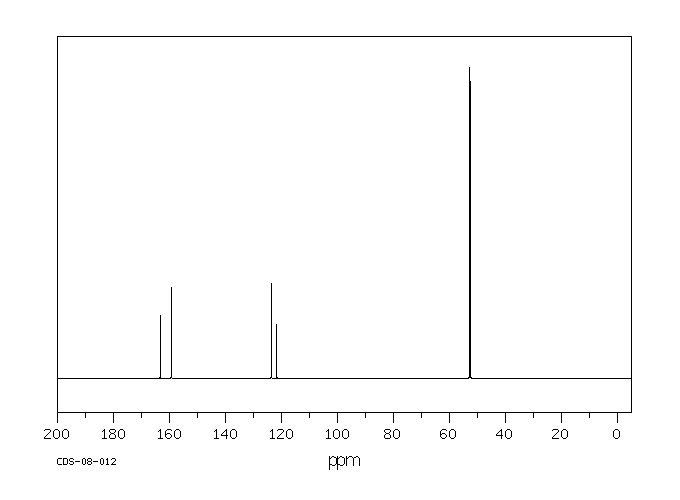tetramethyl 1H-pyrrole-2,3,4,5-tetracarboxylate | 2703-15-3
中文名称
——
中文别名
——
英文名称
tetramethyl 1H-pyrrole-2,3,4,5-tetracarboxylate
英文别名
tetramethyl pyrrole-2,3,4,5-tetracarboxylate;2,3,4,5-tetra(methoxycarbonyl)pyrrole;pyrrole-2,3,4,5-tetracarboxylic acid tetramethyl ester;Pyrrol-2,3,4,5-tetracarbonsaeure-tetramethylester
CAS
2703-15-3
化学式
C12H13NO8
mdl
——
分子量
299.237
InChiKey
IHKXNLWFHWMDMR-UHFFFAOYSA-N
BEILSTEIN
——
EINECS
——
-
物化性质
-
计算性质
-
ADMET
-
安全信息
-
SDS
-
制备方法与用途
-
上下游信息
-
文献信息
-
表征谱图
-
同类化合物
-
相关功能分类
-
相关结构分类
计算性质
-
辛醇/水分配系数(LogP):0.8
-
重原子数:21
-
可旋转键数:8
-
环数:1.0
-
sp3杂化的碳原子比例:0.33
-
拓扑面积:121
-
氢给体数:1
-
氢受体数:8
上下游信息
反应信息
-
作为产物:参考文献:名称:摘要:Thermal, photolytic, and thermocatalytic decomposition of methyl diazoacetate (MDA) in the presence of Rh-2(OAc)(4) or Cu(acac)(2) in refluxing pyridine afforded isomeric trans,cis- and cis, trans- 3,4,5,6 -tetra(methoxycarbonyl) - 1,4,5,6-tetrahydropyridazines (- 1 : 1) in a total yield of 30-70%. Decomposition of MDA in refluxing o-xylene in the presence of Rh-2(OAc)(4) and pyridine (20 mol.%) gave rise to 2,3,4,5 -tetra (methoxycarbonyl)pyrrole in a yield of up to 40%. In these transformations of MDA, neither dimethyl fumarate (or dimethyl maleate) nor the corresponding 2-pyrazolines were generated as intermediates.DOI:10.1023/a:1022421020644
文献信息
-
Cu/Mn Co-oxidized Cyclization for the Synthesis of Highly Substituted Pyrrole Derivatives from Amino Acid Esters: A Strategy for the Biomimetic Syntheses of Lycogarubin C and Chromopyrrolic Acid作者:Nini Zhou、Tao Xie、Lin Liu、Zhixiang XieDOI:10.1021/jo500740w日期:2014.7.3An effective and concise approach to synthesis of tetrasubstituted pyrroles from readily available amino acid esters by the promotion of Cu(OAc)2 in conjunction with Mn(OAc)3 has been developed. This reaction proceeds through multiple dehydrogenations, deamination, and oxidative cyclization. This oxidized system tolerates substrates bearing various electron-donating or electron-withdrawing groups.
-
Reactions of alkyl diazoacetates with pyridinium ylides作者:Yu. V. Tomilov、D. N. Platonov、D. V. Dorokhov、O. M. NefedovDOI:10.1007/s11172-005-0349-6日期:2005.4Pyridinium (methoxycarbonyl)methylide generated from (methoxycarbonyl)methyl-pyridinium halides under the action of K2CO3 reacts with alkyl diazoacetates in CH2Cl2 at 20 °C, resulting in the successive addition of three CHCOOMe fragments from the ylide to form 3,6-bis(alkoxycarbonyl)-4,5-diazaoctadienoic acid diesters. Heating of the latter in the presence of pyridine leads to their isomerization to give tetraalkyl tetrahydropyridazine-tetracarboxylates in high yields. Under more drastic conditions (refluxing xylene in the presence of pyridine), the acyclic tetraesters undergo another transformation to form pyrrole-tetracarboxylic acid esters in yields of up to 60%.
-
Reactions of 2-Hydrazino- and 8-Hydrazinocyclohepta[<i>b</i>]pyrroles with Dimethyl Acetylenedicarboxylate作者:Noritaka Abe、Kumiko YatabeDOI:10.1246/bcsj.64.1704日期:1991.52-Hydrazinocyclohepta[b]pyrrole reacted with dimethyl acetylenedicarboxylate (DMAD) to give the hydrazones (2a), the pyrimidinone-fused cyclohepta[b]pyrrole (3), 1,2,4-triazinone-fused cyclohepta[b]pyrroles, and the 1,2-dihydro-3H-pyrazol-3-one derivative. Thermolysis of 2a gave 3 and tetramethyl pyrrole-2,3,4,5-tetracarboxylate. The reaction of ethyl cyclohepta[b]pyrrole-3-carboxylate with DMAD at
-
Effective synthesis of symmetrical oxygen- and nitrogen-heterocycles from electron-deficient alkynes via the catalysis of electrogenerated base and Fe3+ ions作者:Chuan-Hua Li、Gao-Qing Yuan、Jun-Hua Zheng、Zai-Jun He、Chao-Rong Qi、Huan-Feng JiangDOI:10.1016/j.tet.2011.04.058日期:2011.6An efficient method has been developed for the synthesis of oxygen- and nitrogen-heterocycles from electron-deficient alkynes and alcohol or amines via electrochemically induced two-step process. The first step involves that the electrogenerated base (EGB) catalyzes hydroalcoholization or hydroamination process. In the second step, Fe3+ ions and strong bases electrogenerated can synergically catalyze
-
New route to 1H-aziridines: O-mesitylenesulphonylhydroxylamine addition to electrophilic alkenes
表征谱图
-
氢谱1HNMR
-
质谱MS
-
碳谱13CNMR
-
红外IR
-
拉曼Raman
-
峰位数据
-
峰位匹配
-
表征信息
同类化合物
黄胆红酸
高树蛙毒素
颜料红2254
阿根诺卡菌素
阿托伐他汀镁
阿托伐他汀钙阿托伐他汀钙中间体1甲酯
阿托伐他汀钙杂质59
阿托伐他汀钙杂质52
阿托伐他汀钙杂质43
阿托伐他汀钙杂质
阿托伐他汀钙杂质
阿托伐他汀钙三水合物
阿托伐他汀钙L-8
阿托伐他汀钙
阿托伐他汀酸异丙酯
阿托伐他汀酰基-Β-D-葡糖苷酸
阿托伐他汀缩丙酮
阿托伐他汀相关化合物E
阿托伐他汀甲酯
阿托伐他汀甲胺盐
阿托伐他汀烯丙基酯
阿托伐他汀杂质F
阿托伐他汀杂质95
阿托伐他汀杂质5
阿托伐他汀杂质31
阿托伐他汀杂质1
阿托伐他汀叔丁酯
阿托伐他汀双氟杂质中间体
阿托伐他汀内酯-[D5]
阿托伐他汀内酯
阿托伐他汀乙酯
阿托伐他汀USP相关物质E
阿托伐他汀L1二胺物杂质
阿托伐他汀3-羟基消除杂质
阿托伐他汀3-氧杂质
阿托伐他汀
阿利考昔
阿伐他汀钠
镍(II)(吡唑二氰胺)2
镉原卟啉IX二甲酯
铬,二溴二(吡啶)-
达考帕泛
费耐力
角质形成细胞分化诱导剂
西拉美新盐酸盐
西拉美新
虫螨腈
萨格列扎
苏尼替尼N-1
芬度柳







